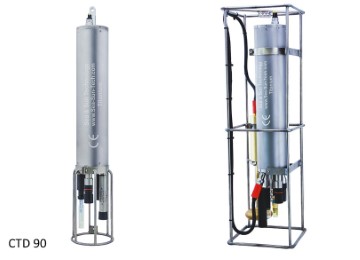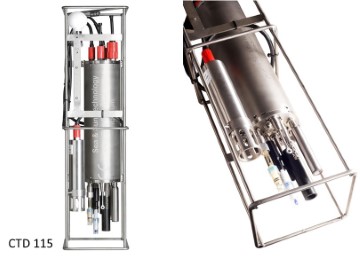CTD probes
marine and freshwater scientific research
overview
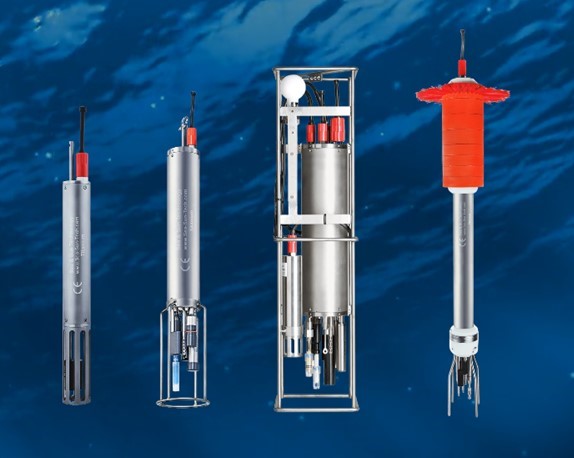 The Sea & Sun Technology range of CTD (conductivity, temperature and depth) probes are high quality, robust, accurate devices for advanced scientific research in any water body.
The Sea & Sun Technology range of CTD (conductivity, temperature and depth) probes are high quality, robust, accurate devices for advanced scientific research in any water body.
Sea & Sun Technology are the world leading manufacturers of scientific CTD probes and are currently being used by all the world's leading research facilities.
Features include:
- Rated to measure to depths of 11,000 metres
- Lightweight, yet robust titanium housing
- Accurate, fast-responding sensors
- Measure a range of parameters including CTD, salinity, dissolved oxygen, pH, redox (ORP), turbidity, hydrogen sulfide, light irradiance, altimeter, fluorometer, and more.
applications
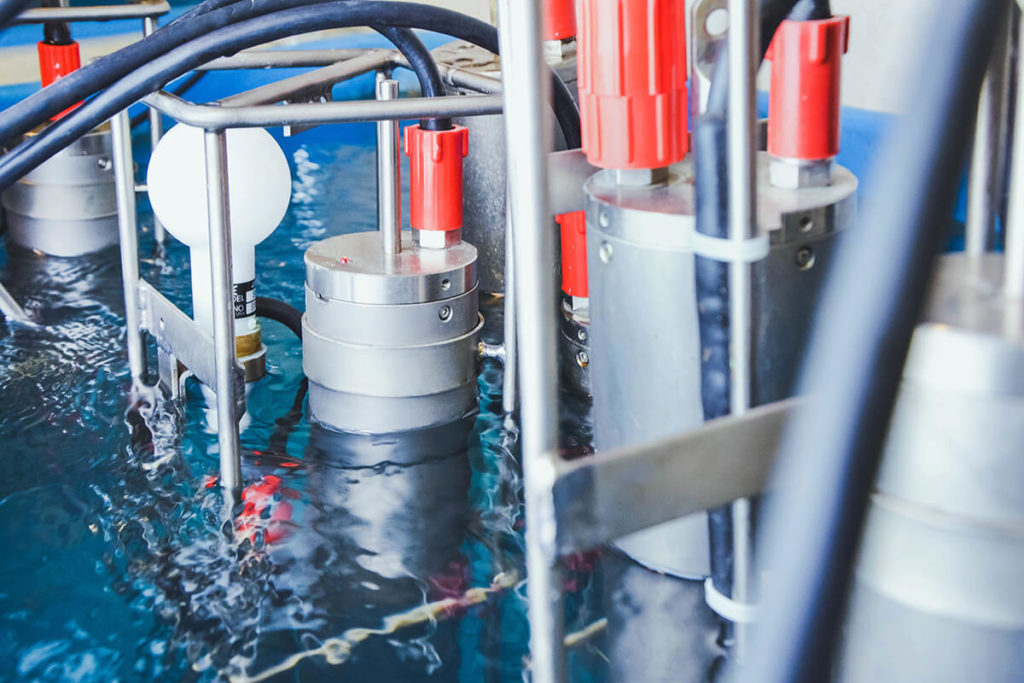 The CTD probes are designed for a range of applications in the marine, seawater and freshwater environments including:
The CTD probes are designed for a range of applications in the marine, seawater and freshwater environments including:
- Oceanography and limnology
- Estuaries
- Global environmental change
- Ocean acidification
- Biodiversity and conservation
CTD 48
 The CTD48 is a high quality, high accuracy 4 channel online probe for oceanographic and limnological measurement of conductivity, temperature, depth and one optional parameter for depth up to 6000 m.
The CTD48 is a high quality, high accuracy 4 channel online probe for oceanographic and limnological measurement of conductivity, temperature, depth and one optional parameter for depth up to 6000 m.
datasheet and specifications
standard models
- CTD 48: online interface with another device via RS-232, RS-485 or FSK cable.
- CTD 48M: data logging or memory unit.
- CTD 48Mc: online or data logging unit.
standard sensors
- Conductivity (С)
- Temperature (T)
- Pressure (D)
additional sensors
- Dissolved oxygen
- Turbidity
- pH
- Redox (OPR)
- Flourometer
detailed information - CTD 48Mc
The CTD48Mc probe is a very small and handy microprocessor controlled multiparameter memory probe for precise measurements as well as for self-contained operation in deep and shallow water with up to 4 sensors and a maximum depth down to 2000 m. It measures conductivity, temperature, pressure and one optional parameter.
The difference between the CTD48Mc and the CTD48 and CTD48M are:
- low weight
- powerful micro controller
- calibration coefficients stored inside the probe
- output of calculated / physical data
- powerful interfaces
- rechargeable batteries (NO opening of the probe!)
The CTD48Mc can work in different modes. One mode is standard SST mode, as with all previous SST probes. In this mode, the data can be read, graphed and saved via an SST program.
In another mode, physical and calculated data, such as salinity, density or speed of sound, can be readout directly as readable characters (ASCII).
online operation
During measurements, the probe must be connected by a cable to a device for displaying and recording measured values. The PC with the “SDA” software application represents the device for displaying and recording measured values in this case. The probe transmits the measured values to this connected data acquisition unit, i.e. the probe does not store any measurement data in its internal data memory. Power is supplied by the internal battery or from an external source.
The online operation is implemented by the following operation mode:
- RS-232 (factory default)
- USB UART (factory default – for configuration and memory readout)
memory operation
The probe can perform measurements automatically and save measurement results internally. Using a configuration cable, a software application transmits to the probe from a PC the settings that control the probe in memory operation. During the actual measurement, no connection is required between the probe and the control unit.
In memory operation, the electrical supply is generally provided by the internal batteries; alternatively, power supply via a connection cable is possible. After measurement, the internally stored measured values are transmitted to a device for storage and display. In this case, the PC running the “SDA” software application is the device con¬figuring the probe and displaying and storing the measured values. The probe can also transfer the currently measured values to a device for display or storage during memory operation and using a connecting cable.
The memory operation is divided into the following operation modes:
- Continuous mode: each data set is stored.
- Time mode: data sets are only stored at programmable intervals with several selectable schemes.
- Increment mode: data sets are stored at programmable depth stamps.
The CTD48Mc is equipped with an 8 channel data acquisition system with 20 bit resolution. High long-term stability and automatic self-calibration of analogue digital converter guarantee stable and precise CTD measurements for many years.
The probe power supply of the is activated by touching a reed contact with a magnetic rod. LED displays power supply status and optical control of memory access.
The supplied Standard Data Acquisition Software package “SST-SDA” includes the handling of the logging process and the display of online or recorded data with a shared graphic user interface.
data transmission and transfer
raw data mode
In this data transmission mode, the probe continuously determines the measured values of the individual sensors through an analog-to-digital conversion. The probe stores the data as the readings of the analog-to-digital conversions. The probe continuously generates raw data sets from the counter readings of the analog-digital conversions and some internal management data. The probe transmits the raw data sets over a binary data protocol to a unit for data display or data storage.
The transformation of raw data into physical quantities is carried out in the software application “SDA” after they have been transferred. The SDA software calculates the physical quantities from the raw data values and associated calibration coefficients. The calibration coefficients were previously determined in a calibration at Sea & Sun Technology GmbH and stored in the configuration files of the SDA software. Thus, only the system consisting of probe and SDA software along with associated configuration files results in a complete measurement system for physical quantities.
physical data mode
In this data transmission mode, the CTD48Mc determines the measured values of the individual sensors through an analog-to-digital conversion. The probe stores the readings as a binary result of the analog-to-digital conversions. The probe receives the calibration coefficients before the actual measurement. The probe transmits the physical quantities via an ASCII protocol according to the NMEA standard to a unit for data display or data storage. The protocol to NMEA requires that the physical units are fixed. This data transmission mode is one of the feature enhancements of CTD48Mc compared to the previous version CTD48M. The letter “c” in “CTD48Mc” stands for “calculated”.
CTD 60
 The CTD60Mc – ultra deep sea is a high quality, high accuracy memory probe for oceanographic measurement of conductivity, temperature, ambient pressure in depth up to 11000 m (12000 dbar)
The CTD60Mc – ultra deep sea is a high quality, high accuracy memory probe for oceanographic measurement of conductivity, temperature, ambient pressure in depth up to 11000 m (12000 dbar)
The CTD60Mc – ultra deep sea is characterised in particular by its ability to directly output physical and calculated data such as salinity, sound velocity and density.
datasheet and specifications
standard sensors
- Conductivity (С)
- Temperature (T)
- Pressure (D)
calculated parameters
- salinity
- sound velocity
- Kappa 25 mS/cm (electric conductivity)
- sigma – t (potential density of a fluid)
detailed information - CTD 60Mc
The CTD60Mc – ultra deep sea probe is a small and handy microprocessor controlled multiparameter memory probe for oceanographic measurement with up to 3 sensors and a maximum depth down to 11000 m. It measures electric conductivity, water temperature and ambient pressure.
Data are stored in a standard flash memory with a capacity of 128 MB. Up to 5,5 million CTD data sets can be recorded on this memory.
online operation
This mode is possible up to 350m via RS-232 Interface, but not recommended for this Probe type. Only for testing.
memory operation
The memory operation is divided into the following operation modes:
- Continuous mode: each data set is stored.
- Time mode: data sets are only stored at programmable intervals with several selectable schemes.
- Pressure mode: data sets are stored at programmable depth steps.
The CTD60Mc – ultra deep sea is equipped with a 8 channel data acquisition system with 20 bit resolution. A high long-term stability and automatic self-calibration of the analogue digital converter guarantees stable and precise CTD measurements for many years.
The probe power supply is activated by touching a reed contact with a magnetic rod. LED displays power supply status and optical control of memory access.
The supplied Standard Data Acquisition Software package “SST-SDA” includes the handling of the logging process and the display of online or recorded data with a shared graphic user interface. The “SST-SDA” is a part of our shipment.
data transmission and transfer
raw data mode
In this data transmission mode, the probe continuously determines the measured values of the individual sensors through an analog-to-digital conversion. The probe stores the data as the readings of the analog-to-digital conversions. The probe continuously generates raw data sets from the counter readings of the analog-digital conversions and some internal management data. The probe transmits the raw data sets over a binary data protocol to a unit for data display or data storage. The transformation of raw data into physical quantities is carried out in the software application “SDA” after they have been transferred.
If the probe is equipped with a USB interface, it is recommended to read the stored data via this interface, since a shorter read-out time can be achieved. The cable length of the USB interface should not be longer than 5m.
The probes are provided with a program (SDA) for the configuration, readout of stored data, numerical and graphical representation of the data and storage of data for all probes in online- or memory mode.
CTD 90
 The CTD90M is a high quality, high accuracy online multi parameter probe with max. 9 sensors for oceanographic and limnological measurement of physical, chemical and optical parameters for depth up to 6000 m.
The CTD90M is a high quality, high accuracy online multi parameter probe with max. 9 sensors for oceanographic and limnological measurement of physical, chemical and optical parameters for depth up to 6000 m.
datasheet and specifications
main features
- easy handling
- up to 9 sensors on the bottom cap
- max. 6 external units
- non-corrosive titanium housing (titanium)
- depth range up to 6000 m
- control and operation of water samplers and plankton nets
- SDA data acquisition software running under various versions of Microsoft Windows
- calculations according to UNESCO formulas
standard models
- CTD90M: 2000 m depth model
- CTD90M: 6000 m depth model
standard sensors
- Conductivity (С)
- Temperature (T)
- Pressure (D)
additional sensors
- Oxygen
- Turbidity
- pH (also H2S-resistant)
- Redox (OPR) also H2S-resistant
- Fluorometer
- Light irradiance(PAR)
- Transmissiometer
- Altimeter
- H2S (hydrogen sulfide)
- Currentmeter (with compass)
detailed information - CTD 90M
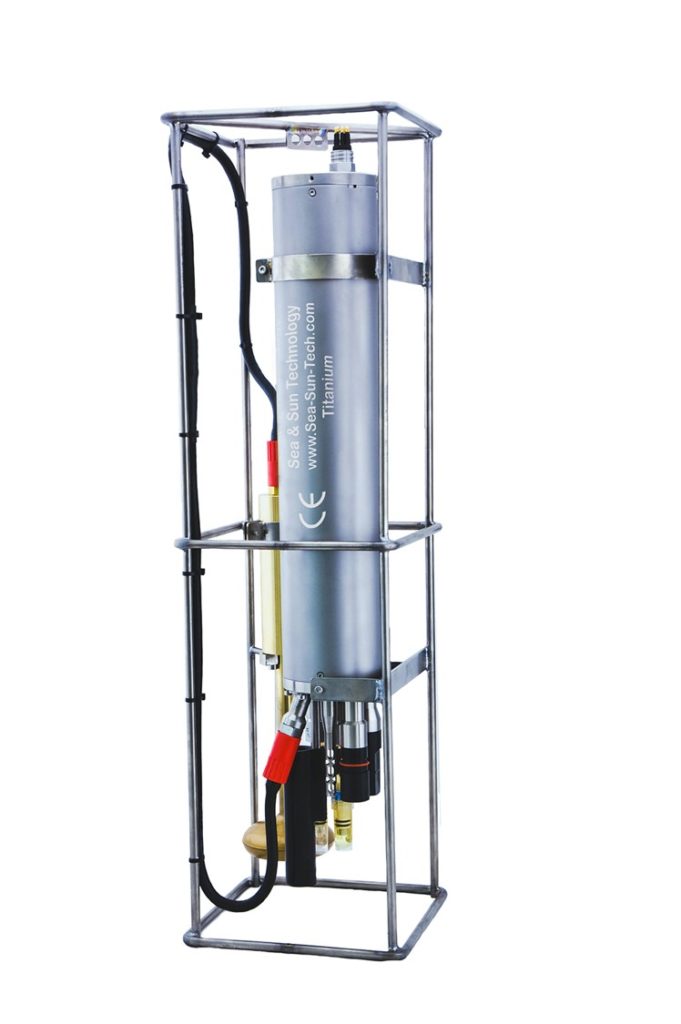 The CTD90M is a high quality, high accuracy multi parameter probe for oceanographic and limnologic measurement of physical, chemical and optical parameters with up to 9 sensors and for maximum depth up to 6000 m.
The CTD90M is a high quality, high accuracy multi parameter probe for oceanographic and limnologic measurement of physical, chemical and optical parameters with up to 9 sensors and for maximum depth up to 6000 m.
Data are stored in a standard flash memory card with a capacity limited to 128 Mbytes by the internal firmware. Up to 3 000 000 CTD data sets can be recorded on this memory. The actual number depends on the selected storage options and the number of sensors adapted to the probe.
The CTD90M allows operation in different modes:
- Continuous mode: each data set is stored.
- Time mode: data sets are only stored at programmable intervals with several selectable schemes.
- Increment mode: data sets are stored at programmable depth increments, up to 255 files can be stored without the need for data retrieval in between.
- Online mode (RS-232).
The CTD90M is equipped with a 16 channel data aquisition system with 16 bit resolution. A high long-term stability and automatic self-calibration of the analogue digital converter guarantees stable and precise CTD measurements for many years.
The supplied Standard Data Acquisition Software package “SST-SDA” includes the handling of the logging process and the display of online or recorded data with a shared graphic user interface. The “SST-SDA” is a part of our shipment.
The power supply of the probe is activated by touching a reed contact with a magnetic rod, LED displays power supply status and optical control of memory access.
data transmission and transfer
The data transfer and the power supply of the probes over longer cables (up to 6000 m) is carried out when using multi-conductor cables (at least 4-wire) via a serial interface (RS-485) or when using a “single-conductor cable” (steel cable with internal conductor) via the FSK- Interface (Freqency Shift Keying).
For shorter cable lengths (up to 500 m) the RS-232 interface can be used. It is also used to configure and readout the data memory.
If the probe is equipped with a USB interface, it is recommended to read the stored data via this interface, since a shorter read-out time can be achieved. The cable length of the USB interface should not be longer than 5 m.
The probes are provided with a program (SDA) for the configuration, readout of stored data, numerical and graphical representation of the data and storage of data for all probes in online or memory mode.
CTD 115
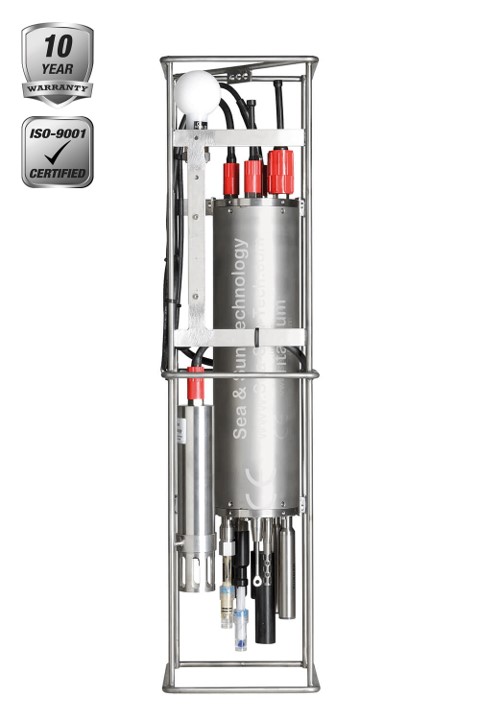 The CTD115M is a high quality, high accuracy online and memory multi parameter probe with max. 11 sensors for oceanographic and limnological measurement of physical, chemical and optical parameters for depth up to 500 m.
The CTD115M is a high quality, high accuracy online and memory multi parameter probe with max. 11 sensors for oceanographic and limnological measurement of physical, chemical and optical parameters for depth up to 500 m.
datasheet and specifications
main features
- easy handling
- up to 11 sensors
- non-corrosive titanium housing (titanium)
- depth range up to 500 m
- control and operation of water samplers and plancton nets
- SDA data acquisition software running under various versions of Microsoft Windows
- calculations according to UNESCO formulas
standard sensors
- Conductivity (С)
- Temperature (T)
- Pressure (D)
additional sensors
- Dissolved oxygen
- Turbidity
- pH (also H2S-resistant)
- Redox (OPR) also H2S-resistant
- Fluorometer
- Light irradiance(PAR)
- Transmissiometer
- Altimeter
- H2S (hydrogen sulfide)
- Currentmeter (with compass)
detailed information - CTD 115M
The CTD115M is a high quality, high accuracy online and memory multi parameter probe with max. 11 sensors for oceanographic and limnologic measurement of physical, chemical and optical parameters up to a depth of 500 m.
Data are stored in a standard flash memory card with a capacity limited to 128 Mbytes by the internal firmware. Up to 3 000 000 CTD data sets can be recorded on this memory. The actual number depends on the selected storage options and the number of sensors adapted to the probe.
The CTD115M allows operation in different modes:
- Continuous mode: each data set is stored.
- Time mode: data sets are stored only at programmable intervals with several selectable schemes.
- Pressure mode: data sets are stored at programmable depth stamps.
- Online mode (RS-232).
The CTD115M is equipped with a 16 channel data aquisition system with 16 bit resolution. A high long-term stability and automatic self-calibration of the analogue digital converter guarantees stable and precise CTD measurements for many years.
The supplied Standard Data Acquisition Software package “SST-SDA” includes the handling of the logging process and the display of online or recorded data with a shared graphic user interface. The “SST-SDA” is a part of our shipment.
The power supply of the probe is activated by touching a reed contact with a magnetic rod, LED displays power supply status and optical control of memory access.
data transmission and transfer
The data transfer and the power supply of the probes over longer cables is carried out when using multi-conductor cables (at least 4-wire) via a serial interface (RS-485) or when using a “single-conductor cable” (steel cable with internal conductor) via the FSK- Interface (Freqency Shift Keying).
For shorter cable lengths (up to 500 m) the RS-232 interface can be used. It is also used to configure and readout the data memory.
If the probe is equipped with a USB interface, it is recommended to read the stored data via this interface, since a shorter read-out time can be achieved. The cable length of the USB interface should not be longer than 5m.
The probes are provided with a program (SDA) for the configuration, readout of stored data, numerical and graphical representation of the data and storage of data for all probes in online or memory mode.




